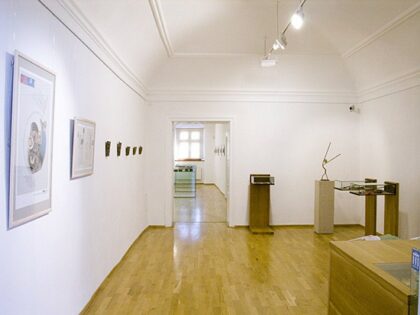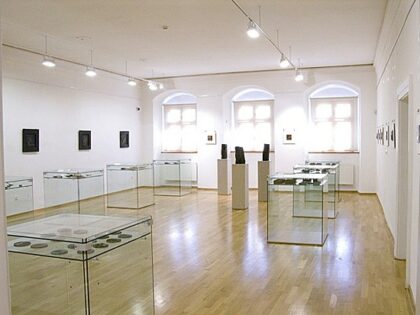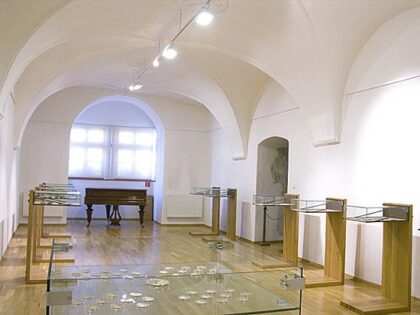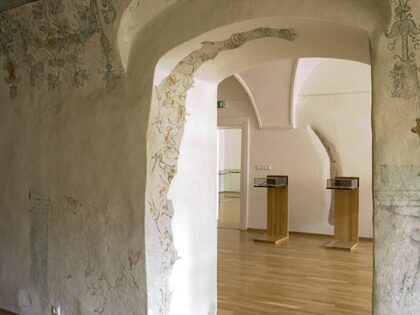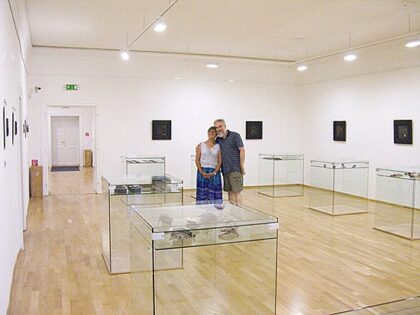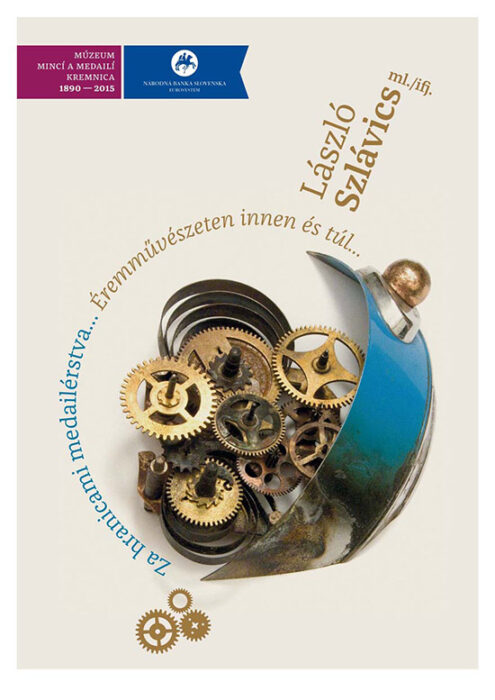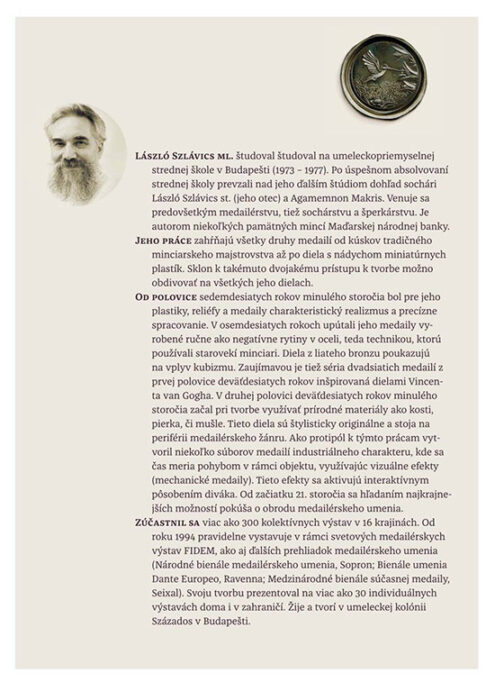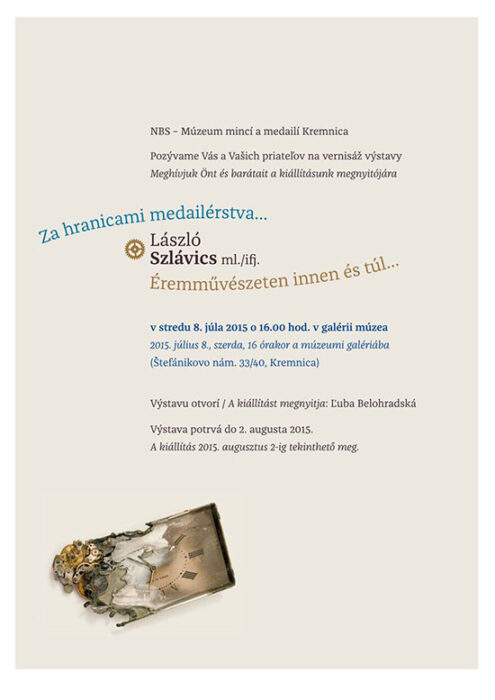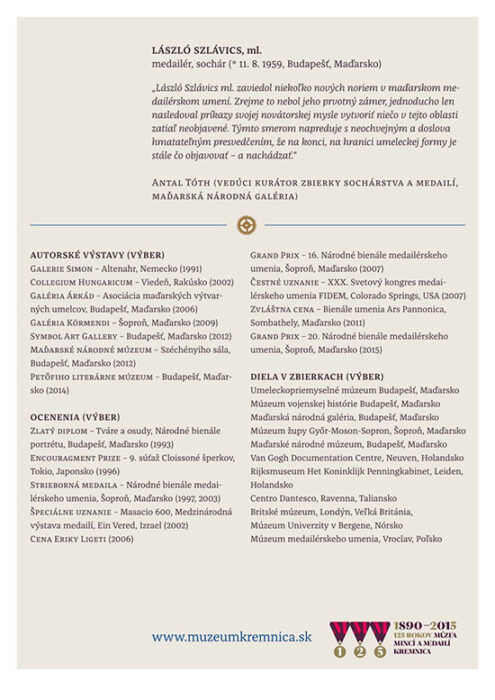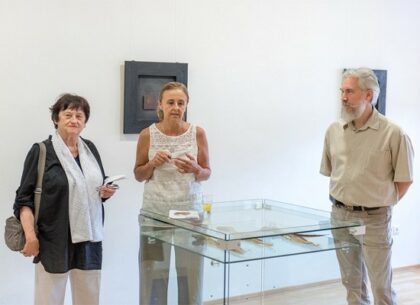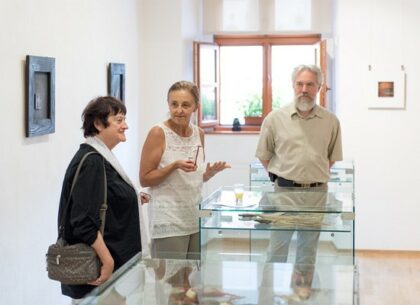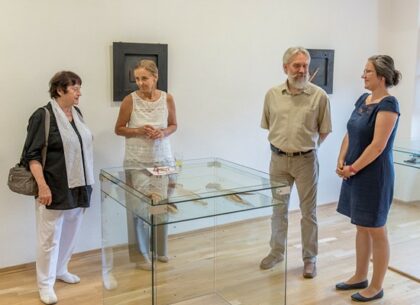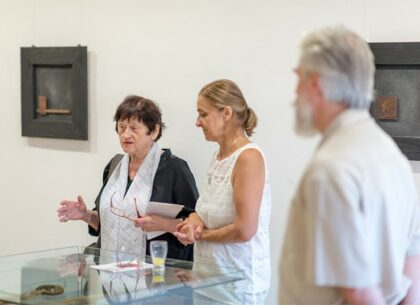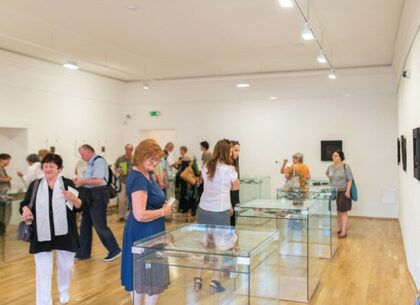There is a solo exhibition of medal art from here and beyond in Körmöcbánya
NBS – Múzeum mincí a medailí Kremnica the Coin and Medal Museum of the National Bank of Slovakia invites you and your friends
Wednesday, July 8, 2015 at 4 pm in the gallery of the museum for the opening of the solo exhibition of the sculptor and medalist László Szlávics Jr.
The exhibition will be opened by art historian Ľuba Belohradská.
Available until August 2,
LÁSZLÓ SZLÁVICS junior – medallist without limits
Let me begin with some biographical details about László Szlávics junior. Like his eponymous father, his background is in sculpture. There was, so to say, a seamless transition from the nursery to the sculptor’s workshop. In such circumstances an artist quickly gains the expertise and mastery that most novice sculptors would acquire only after a lengthy training process. The rest is then a question of an inborn talent that lays the basis for the career.
In the field of music we speak of ‘child prodigies’ whose extraordinary abilities are apparent from an early age. After completing secondary education at the School of Applied Arts in Budapest, Szlávics joined his father’s workshop in order to refine his skills. He was guided by both his father and by the prominent Greek sculptor Agamemnon Makris (who had enriched the local sculpture scene after being granted political asylum in Hungary).
The late 1970s, when Szlávics junior emerged as a sculptor in his own right, was a time of key events in the history of Hungarian medallic art, when in 1977 the Hungarian National Gallery hosted a memorable edition of the FIDEM international art medal congress, and the same year saw inaugural editions of both the Nyíregyháza-Sóstó international symposium of cast medals and the National Biennale of Medallic Art (the Biennale, held in the western Hungarian town of Sopron, was hosted for the twentieth time in 2015).
The opportunity to share creative insights about medallic art directly at events in Budapest was a catalyst in the development of the young Szlávics as a medallist. His decision to focus on designing medals and plaques may also have been inspired by the art medal exhibition at the FIDEM congress.
In almost four decades as a medallist László Szlávics has employed every historical technique known in the craft. For example, he has created struck medals by engraving a steel matrix and then striking the medal by hand (a technique also used by the Austrian artist Helmut Zobl, who won second prize at the Kremnica International Quadrennial of Medallic Art in 1992). His work in cast medals and plaques displays extensive refinements.
In line with evolving trends in the last third of the 20th century that saw increasing crossovers between medals, plaques and artwork, Szlávics enhanced his range of artistic techniques with the addition of assemblage – capturing the poetics of objets trouvés in such a way as to inspire new and significant associations. Assemblage has allowed the artist to link together various discarded objects of modern civilisation (for example, clock mechanisms and faces, corroded iron), or new materials and technologies not typically associated with medals (for example, plexiglass combined with a photographic image or with white shiny metal), as well as organic materials (such as specially treated animal bones, feathers of exotic birds, seashells and cork), or sand and paper. For this artist, wood has a special place in the hierarchy of materials. We might expect him to carve wood, but Szlávics makes do with sanding, rasping and arranging fragments, and then, as it were, sewing them together with metal attachments. He exploits the subtly differentiated colour shades of the surface facture and the internal structure, which is revealed through sanding and then transformed through charring.
The age of the wood fragment – or ‘the memory of the wood’ – becomes the direct bearer of the message conveyed by the particular work, in other words a philosophical meditation about the time and processes of expiration. By softening the relief composition, the artist achieves a kind of image relief.
Let us turn our attention to the message of Szlávics’s medallic art and sculpture workshop, with formal perfectionism being a sine qua non of the artist’s personal message.
The core thematic cycle comprises struck medals portraying leading figures from Hungary’s past and from the sciences and arts. From a conventionally designed medal disc, Szlávics sets to work on the body of the medal, cutting out the space into which he inserts the portrait (of, for example, Dante, Andersen, Masaccio).
In later works, he turned the portrait into a form of assemblage (seen, for example, in the ‘Family’ cycle depicting his father, mother, sister and himself) that incorporates photographic images. This technique was also applied in his ‘Tribute to the masters’ cycle. In portraying the artists Kassák, Moholy-Nagy and Haraszty, he uses not only photographs but also their own works as a form of attribution.
Szlávics’s medals represent a coherent axis of inspiration and thought that evokes historical reference to constructivism, which has been a continuous feature of Hungarian fine art from Kassák and Moholy-Nagy through to contemporary forays into deconstruction or the light ironising paraphrase – as exemplified in the work of Szlávics’s friend and sculptor István Haraszty.
Philosophical seriousness and intellectual depth are revealed in what are known as the meditation cycles – devoted to ancient cosmological ideas about the essence of the world (symbolised by the four elements: earth, air, fire and water), in the appellative ecological cycle warning about water pollution, and in the cyclical apocalyptic ‘relief images’, which are assemblages providing the artist’s personal interpretation of things that happened in the 20th century.
A key symbolic construct of Szlávics’s artistic language is the depiction of the house, the dwelling, or the devastated ruin. In this regard, it is worth noting the use of such symbolism in Hungarian sculpture, where the house and its internal space takes on the spiritual quality of a ‘cover’ for the human story, as we can see, for example, in the work of the sculptor Erzsébet Schaár in the second half of the 20th century.
Szlávics became a committed devotee of the mythologies of natural nations and of the magical, irrational and even miraculous shamanic practices associated with them. In his beautifully vivid and jewel-like ‘shamanic coins’ there are loose artistic allusions to the ritual adornments of Indian medicine men and tribal chiefs.
To the field of contemporary Hungarian and European medals, plaques and chamber reliefs, Szlávics has introduced a symbiosis of the raised element and richly shaded surface colour. In this way his works achieve a fullness of expression.
The exhibition of works by László Szlávics junior is a highlight of the current season at the Gallery of the NBS Museum of Coins and Medals in Kremnica, which has previously exhibited other distinguished medallists from both Slovakia and abroad, such as the Bulgarian Bogomil Nikolov, the Czech Jiří Vlach, and the Pole Jacek Dworski.
Ľuba Belohradská
Kremnica, 7 and 8 July 2015
